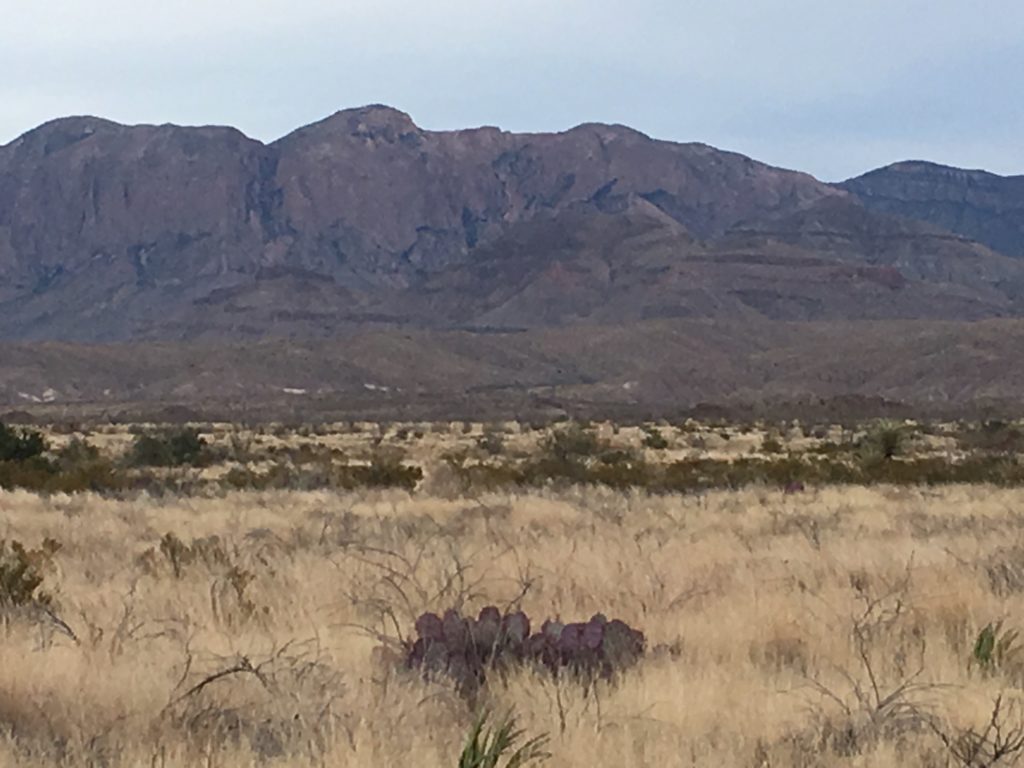by Ruth Ann Grissom
January 11, 2018
 In December, as I packed for a trip to Big Bend National Park, I ran across a quote attributed to Edward Abbey. The desert will scour your soul. His words evoke the grit of the desert, but they also embody the promise of emerging polished and pure. They struck a chord with me. I had suffered some wounds on my soul, and the scars had calloused into bitterness. If any place was capable of abrading them, it was Big Bend.
In December, as I packed for a trip to Big Bend National Park, I ran across a quote attributed to Edward Abbey. The desert will scour your soul. His words evoke the grit of the desert, but they also embody the promise of emerging polished and pure. They struck a chord with me. I had suffered some wounds on my soul, and the scars had calloused into bitterness. If any place was capable of abrading them, it was Big Bend.
I’ve visited other desert parks – Death Valley, Joshua Tree, Organ Pipe and Arches – but Big Bend is the one that captured my heart. Off the beaten path in far West Texas, it remains one of our least visited national parks. It’s a place of solitude and solace, where a self-contained mountain range rises abruptly from the Chihuahuan Desert. The Rio Grande holds its half-million acres as if it were a treasure cradled in a palm. Here, Mexico lies to the south, but also to the east and west. It messes with your perspective.
The desert is luminous in winter. The solstice sun hugs the horizon. Grasses are parched and hollow, but when they’re backlit from such a low angle, they glow. So do the golden thorns of Christmas cholla. Yuccas and sotols positively shimmer. Even the humble pads of prickly pear cactus revel in their reflection of the thin, clear light. There is so much beauty here among the rocks and thorns.
A gentle trail leads us toward the Chimneys, a line of eroded dikes that has long served as a landmark in the desert. From a distance, it brings to mind the jagged teeth in the jawbone of a coyote’s skull. One is etched with Indian petroglyphs – circles, hash marks and squiggles. I wonder at their meaning. Another features a large overhang that creates an appealing shelter. The remains of a stacked stone wall further define the space. Inside, there are ancient stone metates used to grind mesquite beans or grains.
I think of the women who lived here, over the course of hundreds or thousands of years. As they worked, perhaps they gazed across the desert toward Santa Elena Canyon, the dramatic cleft in the distant cliffs, waiting for loved ones to return from a battle or hunt. Their lives must have been riddled with hardship and tedium. I hope there were also moments of pleasure, comfort and awe – the last warm rays of a winter evening’s sun, the midday shade of the overhanging rock, the sight of a thundercloud building over this magnificent landscape.
We continue past the Chimneys, on toward Pena Spring. The area surrounding us is cut with washes that channel water rushing off the nearby hills and mountains. They are dry today, but the monsoon rains finally came this fall, a welcome respite after many years of drought. The week before our arrival, there was even a substantial snow. I expect there will be a spectacular wildflower display come spring.
In the meantime, I’m stunned to find a few bright red blooms atop the spindly sticks of ocotillo. The large, vase-shaped shrubs otherwise look dead. Their common name, coachwhip, speaks of cruelty, but these days the branches are more often used as fencing. In the spring, after ample rains, they are plush with small, green leaves. These are quickly shed when the weather turns dry. Photosynthesis is sacrificed in order to conserve moisture. Many desert species have similarly clever adaptations that allow them to survive during challenging times.
On our return, the sun is setting behind us. Evening turns the Chisos Mountains purple in the distance, the color echoed in the clumps of purple-tinged prickly pear cactus scattered along the trail. We startle up flocks of back-throated sparrows and several coveys of quail. Our presence sends them twittering and clucking into the shrubs. A male Northern harrier skims the prickly brush, looking for one last meal to sustain him through the cold descending with the night.
I spot a rock cairn painstakingly arranged in the shape of a heart. I’d missed it on the way in. Carefully selected sticks are laid out in the center to form a capital C. An early Valentine? An earthy memorial? A note for a fellow hiker? The intent remains as cryptic as the petroglyphs, but I do know this: After thousands of years, we’re still inspired to leave our special messages in the desert.
Another day, while hiking the Mule Ears trail, I will notice unusual markings on a large, sprawling prickly pear cactus. It appears someone has used a pocketknife to slash a line and gouge two holes in one of the pads. The wounds have healed, leaving a smiley face. I normally frown upon defacing a protected, sacred place, but in that moment, for a moment, I return the smile. I then continue on my way, step by step, along the rocky trail.
Stay Connected
Sign up for our newsletter and stay up to date on news, events, and all things local conservation.

Connected to the Land.
Committed to Conservation.